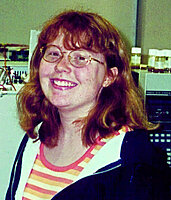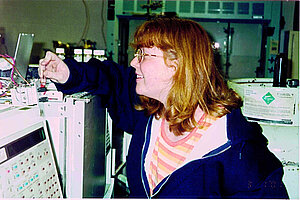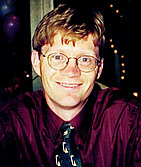Rapid Spray Extraction and Analysis of Organic Compounds from Water

Melissa J. Meyer is in her third year of graduate study in the UND Chemistry Department. Her research interests include spray extraction processes, high speed GC, and mass spectrometry. She was one of 38 graduate students from the US selected to attend the 50th Meeting of Nobel Laureates in Lindau Germany. Melissa is a native of St. Paul, MN, and a 1997 graduate of Viterbo College. After completing her graduate studies, she plans on a career in the industrial sector.
Fellow: Melissa J. Meyer, Department Chemistry, UND
Advisor: Anthony J. Borgerding, Assistant Professor of Chemistry, UND
Cooperator: Dakota Technology, Inc., Fargo, ND
Degree Progress: Ph.D. expected in 2003.
Rapid Spray Extraction and Analysis of Organic Compounds from Water
This research focuses on rapid extraction and analysis of volatile organic compounds (VOCs) from water to the gas phase for subsequent analysis. This group of compounds includes EPA priority pollutants such as benzene, toluene, dichloroethane, chloroform, and many others. While the time required for chromatographic and spectroscopic analysis of these compounds has been decreased with recent advances, extraction and sample preparation has largely been overlooked. As a result, many of these new analysis techniques are incompatible with older, slower extraction techniques. The Borgerding group has recently developed a spray chamber that allows extraction of VOCs in less than 30 seconds. This system is therefore compatible with fast analysis techniques such as high-speed gas chromatography (HSGC) and ion trap mass spectrometry (ITMS). Interfacing these techniques with the rapid spray extraction device is a main objective of this project.
Spray extractors are constructed from commercial stainless steel fittings and cylinders. Water samples are injected using a syringe into a counter-current stream of nitrogen or helium, and the volatile analytes are extracted into the gas phase. As a result, an analyte pulse exits the extractor. If desired, water vapor can be selectively removed from this pulse, and compounds can be cryofocussed into a more concentrated band before analysis using HSGC or ITMS. The resulting measurements of the extracted water samples have sub-ppb detection limits, have the normal selectivity range offered by GC and MS methods, and are completed in less than 1 minute. Successful implementation of this system will be very helpful to our long-term goals of studying fast changing processes in a variety of natural settings. This new instrumentation is vital to making the rapid, sensitive, and selective measurements on complex samples required in these studies.


Anthony J. Borgerding
Chemical Engineering
UND


